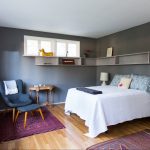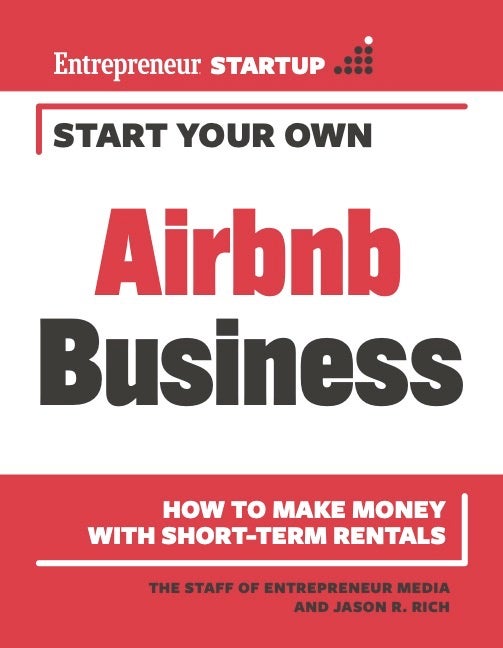Opinions expressed by Entrepreneur contributors are their own.
In the new book, Start Your Own Airbnb Business, author Jason R. Rich breaks down all of the possibilities of making money with short-term rentals. In this excerpt, he speaks with the husband-and-wife team of Zev and Melissa Forrest, who operate 11 Airbnb short-term rental units and have been doing it since 2018.
Buy now: Entrepreneur Bookstore | Amazon | Barnes & Noble
How did you initially get started with Airbnb?
Zev Forrest: We attended a free workshop about five years ago, before my wife and I got married. After attending the workshop, we tested the waters by approaching my mother, who used to rent out her backhouse to long-term tenants. I shared all the information we learned and began offering her accommodations as a short-term rental through Airbnb. It quickly became a profitable endeavor. When Melissa and I went on to buy our own house, we knew we loved the hospitality industry and decided to offer rooms in our home through Airbnb. Over time, we expanded our portfolio to 11 units, and now operate them as our full-time jobs. We have 10 separate properties, and one of them is a single property with two listings. All are located within Southern California.
When selecting your properties, what did you look for to help ensure they’d be profitable for short-term rental through Airbnb?
Zev Forrest: First, I researched the location’s short-term rental ordinance to make sure the property could be used as a short-term rental property via Airbnb. Our other criteria are constantly evolving, since our goals are changing based on how we see our company’s brand. At first, we looked at single-family homes that could fit 8 to 10 people. Later, we started looking at one- or two-bedroom apartments as well that could accommodate traveling couples or corporate professionals. Now, our focus has been on mid-to-high-level luxe, single-family home properties located along the coast.
My wife handles the day-to-day operation of our short-term rental business. I work full-time analyzing real estate deals so we can expand our portfolio. When I first look at a property, I always use the AirDNA service to acquire a detailed analysis in terms of its profit potential as a short-term rental property. This service can be a bit pricey, but we have found it’s well worth the investment. If that report comes back favorable, I then look at Airbnb itself and search for similar listings to the property we’re interested in acquiring that are in the same geographic area. I seek out geographic areas that have at least 10 different Airbnb properties with at least 40 reviews each.
If the reviews are above 4.6, generally I consider this to be a good area to acquire a property. I also look at the occupancy rate of these other nearby properties and believe a 60 percent occupancy rate or higher is favorable. Then, depending on the size of the property, I look at the income potential, compared to what the mortgage and operating costs for that property will be, in relation to what we calculate will be the average nightly rate we could charge for that property. For a single-family home, after crunching the numbers before purchasing the property, I am seeking out at least a 30 percent return on the investment. If we’re subleasing a home and using rental arbitrage, we’re looking to earn between 1.5 to 2 times the lease payment that we’d be paying.
When you first got started with your short-term rental business, how much capital did you originally have and how did you quickly expand the business to include 11 units?
Zev Forrest: The first property we started with was one we purchased for 10 percent down via a conventional loan. Speak with a mortgage broker or real estate attorney to figure out the lowest amount of money you can put down for an investment property, and the type of loan you should seek out. The property was priced around $370,000, but after the closing costs and other fees, this was another $60,000. After that, we spent about $12,000 to furnish and decorate the three-bedroom, 1,500-square-foot home. After acquiring this investment property, we did not have the funds to purchase others right away, so we began leasing additional properties and taking advantage of rental arbitrage. This is when you rent someone else’s property for a long term and then sublease it out and manage it as a short-term rental property with the landlord’s permission. So, if we are spending $2,000 per month for the long-term lease of a property, we aim to earn $4,000 per month using it for short-term rentals through Airbnb. We then earn that $2,000 spread. Through rental arbitrage, we were able to scale our business very quickly, because we were able to show the various landlords our proof of funds to support the long-term leases.
Buy now: Entrepreneur Bookstore | Amazon | Barnes & Noble
Now that you operate 11 short-term rental units, do you rely on property managers to help you manage them?
Melissa Forrest: For the first few years, I managed the day-to-day operation of the properties and managed the cleaners and maintenance people. More recently, we have built a team that’s comprised of virtual assistants that I have trained to handle the day-to-day operations involving the guests and the cleaners. The virtual assistants can make financial decisions up to a certain limit before getting me or my husband involved if there’s an emergency. Because they are virtual assistants, this keeps our costs low. Rounding out the team, we have a reliable cleaning service and a maintenance service that is local to each unit. I initially find these services on TaskRabbit or Thumbtack, and then build up a relationship with them. For example, the cleaning service or maintenance service will also act as a runner, so if a guest calls and says they need extra towels, for example, the runner will quickly deliver them to the property. The virtual assistants handle all the communications with the guests.
For new Airbnb hosts, I recommend having a list of 24-hour plumbers and electricians on call in case an emergency happens. For cleaning services, I originally used a professional cleaning company, but that was a nightmare. They sent out different cleaners to the properties each time, so there was a huge lack of consistency. We found it is much more economical to hire independent contractors as our cleaners, and they’ve turned out to be much more reliable and consistent. We often find cleaners through referrals and through social media. We can train them to clean and prepare each property for guests exactly how we want it done. The cleaners get to know the ins and outs of the property and how to maintain consistency when preparing and staging each property for each guest. The service called Turno can also be used for finding reliable cleaners, for example.
What strategy do you use to set your nightly rates?
Melissa Forrest: We look at comparable Airbnb properties in the area and pay attention to what the highest-rated and most successful properties are charging. I take this information and then use a dynamic pricing tool, called PriceLabs, to help us set a base nightly price. We then set a minimum price, which is the lowest rate we’re willing to go for each unit. The dynamic pricing tool helps us set the optimal price, based on a wide range of factors. This service updates our pricing daily for each property. We believe using a dynamic pricing tool, like PriceLabs, is an absolute necessity for all Airbnb hosts. Not using a tool like this leaves a lot of money on the table.
To read the full article, Click Here





